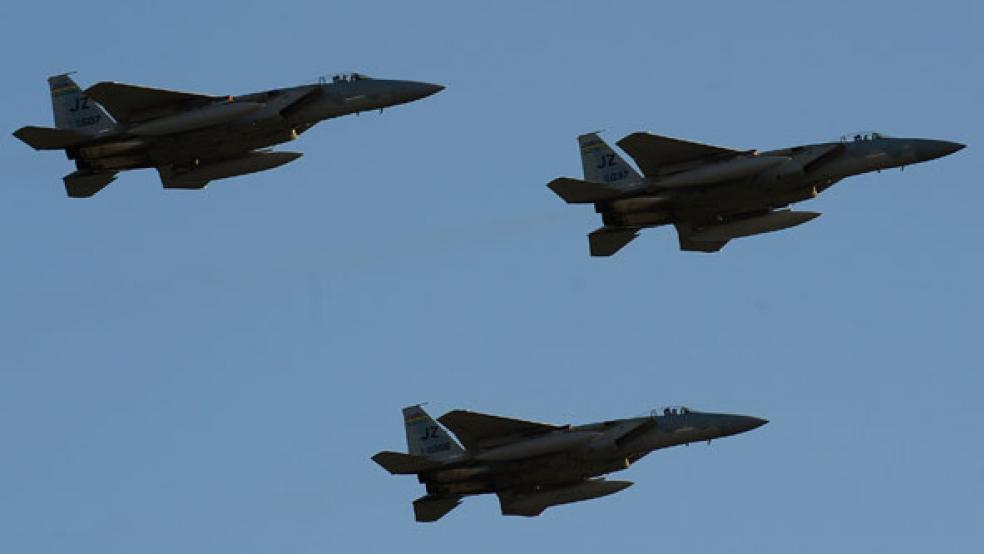President Trump, Congressional Republicans and Congressional Democrats don’t agree on much, but they’re mostly united in the belief that we should spend tens of billions of additional dollars on defense. It is less clear that threats the U.S. faces justify the extra funding or that bureaucrats can spend the new money effectively.
Although just about everyone agrees that defense spending should go up, the details are up for debate. The Trump administration has proposed to spend $603 billion on defense in 2018, which is $54 billion above the sequestration caps set during the 2011 budget compromise. Republican hawks led by Sen. John McCain say that the administration number is insufficient. They want to see a $640 billion military budget. On the Democratic side, Sen. Dick Durbin indicated support for Trump’s number so long as Republicans agree to also break the sequester caps on domestic spending (highly unlikely).
Related: The Five Biggest Winners and Losers in Trump’s Fiscal 2018 Budget
The final number, which will be somewhere between $603 billion and $640 billion, is huge — but is only part of what the U.S. government spends to counter foreign rivals. Each year, Congress also appropriates money to Overseas Contingency Operations — a slush fund created for emergency security spending created in the wake of 9/11. In fiscal 2016, Congress authorized $58.6 billion in defense-related OCO spending. Trump proposes to raise this amount to $65 billion in 2018. This means we are looking at total military spending approaching $700 billion, or about 3.5 percent of next year’s nominal GDP.
It doesn’t end there. The skinny budget does not include money for the National Intelligence Program, which funds the CIA, NSA and other spying agencies, but for 2017 these agencies requested a total of $53.5 billion. Also excluded from reported defense spending totals is the Department of Veterans Affairs, which addresses the human consequences of our past deployments. The VA would see its discretionary funding raised from $74.5 billion this year to $78.9 billion next year under Trump’s budget blueprint, a 6 percent increase. That’s on top of mandatory spending of more than $100 billion this year. In total, the VA budget has nearly doubled since 2009 and looks likely to escalate further under the new administration.
So, all told, our nation’s defense establishment can be expected to cost us over $900 billion annually during the Trump years — closer to 4.5 percent of GDP.
Related: Why Trump Shouldn’t Give the Pentagon Another Dime
Political leaders justify the military buildup by citing a list of threats that typically include Russia, China and Islamic terrorism. But none of these threats approach the severity of that posed by the Communist bloc during the Cold War, when all of Eastern Europe was under the control of a hostile power. Yet, in real dollars, proposed defense spending exceeds the annual military budget at the height of the Cold War.
Today, Russia is a mere shadow of the former Soviet Union, with a stagnant population less than half the size of ours and an economy that is about one twelfth of ours in nominal GDP terms. Yet the media is full of scare stories about the power and ruthlessness of Russia’s leader, Vladimir Putin.
Related: The US Navy’s $13 Billion Answer to China and Russia
The simple fact that Putin is a bad guy does not make the case for a defense buildup. It only makes sense to spend money to counter Russia if Putin is really a threat to us. Admittedly, Russia has enough nuclear weapons to kill everyone on the planet many times over. But there is every reason to believe that Putin, like all of his Soviet and Russian predecessors since World War II, is deterred from using his nuclear arsenal by the existence of our nuclear arsenal.
So we don’t need to send billions more to the Pentagon to avoid a Russian attack on U.S. territory. The more plausible concern is that, without a strong counterforce, Putin will continue to grab territory from adjacent states as he did with Georgia in 2008 and more recently in Ukraine. But these situations are half a world away and have virtually no impact on our economy. From the perspective of Trump’s “forgotten men” — the laid-off coal miners and manufacturing workers in the nation’s heartland — events on the periphery of Russia’s borders might as well be happening on Mars.
China is a more plausible economic rival but that nation has no history of global expansionism. As with Russia’s border incursions, China’s aggressive claims in the South China Sea are of little consequence to the average American.
Related: Tillerson’s Asia Trip Could Signal the End US Soft Diplomacy
ISIS, al Qaeda and other radical Islamist groups have expressed designs on American civilians and have inspired lone wolf attacks on the homeland in recent years, but they have been unable to repeat the spectacular attacks of 9/11. These groups are small — with total forces numbering in the tens of thousands — and are constantly weakened by their reliance on suicide attacks. Also, they are almost universally reviled; many other countries are fighting them or are willing to do so. As Trump has repeatedly suggested, Russia could be an ally in cost-effectively fighting radical Islam.
The rest of the U.S. establishment seems bent on stopping such cooperation. Democrats and their mainstream media allies, eager to undercut Trump’s legitimacy, continue to play up his campaign’s links to Russia. To accentuate the issue, they demonize Putin and exaggerate the impact of Russian propaganda. Republican hawks like McCain and Sen. Lindsay Graham, who see every foreign policy issue through the prism of the late 1930s (when the Nazis gobbled up Europe while Chamberlain appeased and the Americans slept), can’t fathom the idea of cooperating with the Russian strongman for any reason whatsoever.
Due to this intransigence and political backbiting, we are obliged to fight Islamic terrorism largely on our own. Yet, given the small and decentralized nature of this threat, it is best countered by law enforcement and relatively inexpensive special forces; our heavy weapons and most of our 1.4 million Army, Navy and Air Force personnel are largely irrelevant.
Related: F-35s and Navy SEALs: Trump’s Powerful Warning to North Korea
Given all that, it is hard to see how billions more for defense will benefit the typical American not employed by a weapons contractor. But even for those who believe the opposite, there is a second question: Can the Department of Defense use the new money effectively? Evidence from years of oversight suggests not.
DOD has serious financial management issues. Unlike other federal agencies, it is unable to produce financial statements that can pass an external audit. Indeed, for fiscal 2016, it has yet to provide any financial statements at all. DOD’s financial management issues have been on the General Accounting Office’s high risk list since 1995.
As The Fiscal Times has previously reported, DOD was unable to account for billions of dollars it spent in both Iraq and Afghanistan. More recently, DOD’s Inspector General found that the U.S. Army made $6.5 billion in unsupported year-end adjustments to close its books in 2015.
Related: The Navy’s $35 Million Scandal: Hookers, Booze and a Guy Named ‘Fat Leonard’
So even if the DOD really needs new money to better counter external threats, there is little assurance that it will spend that new money wisely. Republicans often criticize Democrats for throwing money at dubious government programs irrespective of necessity or results, but the GOP’s approach to military spending reveals their hypocrisy. Republican warnings about budget deficits, unsustainable entitlements and government waste ring hollow when it is obvious that they are willing to lavish billions more on the military-industrial complex without insisting on accountability or even a compelling case in terms of cost and benefit.






